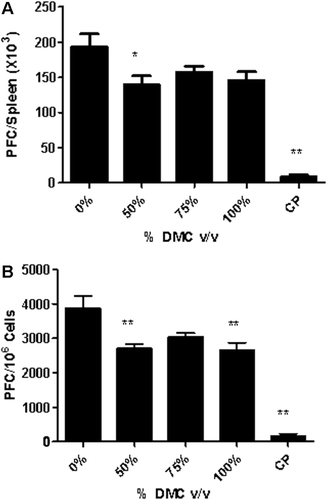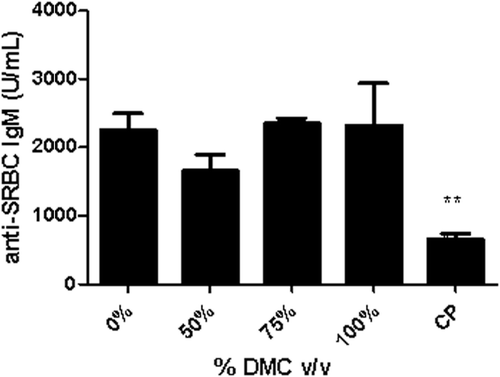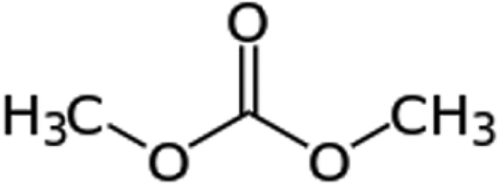Figures & data
Figure 2. Irritancy and allergic sensitization potential after dermal exposure to DMC. Analysis of the (a) irritancy and (b) allergic sensitization potential of DMC using the combined irritancy/LLNA. DPM represent [3H]-thymidine incorporation into draining lymph node cells of BALB/c mice following exposure to vehicle or concentration of DMC. Bars represent mean (± SE) of five mice (10 ears; irritancy) per group. Levels of statistical significance are denoted (** p < 0.01) as compared to acetone vehicle.
![Figure 2. Irritancy and allergic sensitization potential after dermal exposure to DMC. Analysis of the (a) irritancy and (b) allergic sensitization potential of DMC using the combined irritancy/LLNA. DPM represent [3H]-thymidine incorporation into draining lymph node cells of BALB/c mice following exposure to vehicle or concentration of DMC. Bars represent mean (± SE) of five mice (10 ears; irritancy) per group. Levels of statistical significance are denoted (** p < 0.01) as compared to acetone vehicle.](/cms/asset/26808257-e1ec-43f6-ad8c-decdcf4f867b/iimt_a_691124_f0002_b.gif)
Table 1. Body/organ weights of female B6C3F1 mice dermally exposed to dimethyl carbonate for 28 days.
Table 2. Hematology parameters of female B6C3F1 mice dermally exposed to dimethyl carbonate for 28 days.
Table 3. Effects of dermal exposure to dimethyl carbonate for 28 days on total spleen cell number and of lymphocyte sub-populations in female B6C3F1 mice.
Figure 3. DMC suppresses the spleen IgM response to SRBC. Analysis of antibody producing spleen cells after a 28-day dermal exposure to DMC suppressed the (a) total and (b) specific activity IgM response to SRBC. Bars represent mean fold-change (± SE) of six mice per group. Cyclophosphamide (CP) was included as the positive control.

Figure 4. DMC exposure does not alter the serum IgM response to SRBC. Analysis of serum after a 28-day dermal exposure to DMC did not produce alternations in IgM response to SRBC. Bars represent mean fold-change (± SE) of six mice per group. Cyclophosphamide (CP) was included as the positive control.

